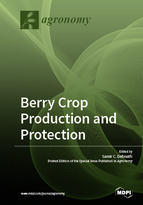Berry Crop Production and Protection
A special issue of Agronomy (ISSN 2073-4395). This special issue belongs to the section "Horticultural and Floricultural Crops".
Deadline for manuscript submissions: closed (31 December 2018) | Viewed by 53878
Special Issue Editor
Interests: berry crops; breeding; biodiversity; biotechnology; genetic enhancement; in vitro culture; micropropagation; molecular marker; wild germplasm
Special Issues, Collections and Topics in MDPI journals
Special Issue Information
Dear Colleagues,
Berry crops include, but are not limited to, the genera: Fragaria (strawberry, Rosaceae), Ribes (currant and gooseberry, Grossulariaceae), Rubus (brambles: raspberry and blackberry; Rosaceae), Vaccinium (blueberry, cranberry and lingonberry; Ericaceae) and Vitis (grapes, Vitaceae). The significant role of these fruits in maintaining human health has increased their popularity and production, dramatically, across the world. This Special Issue of Agronomy will cover berry crops in the areas of breeding, genetics, germplasm, production systems, propagation, plant and soil nutrition, pest and disease management, postharvest, health benefits, marketing and economics and other related areas. The aim will be to bring together a collection of valuable articles that will serve as a foundation of innovative ideas for production and protection of health-promoting berry crops in changed environment.
Dr. Samir Debnath
Guest Editor
Manuscript Submission Information
Manuscripts should be submitted online at www.mdpi.com by registering and logging in to this website. Once you are registered, click here to go to the submission form. Manuscripts can be submitted until the deadline. All submissions that pass pre-check are peer-reviewed. Accepted papers will be published continuously in the journal (as soon as accepted) and will be listed together on the special issue website. Research articles, review articles as well as short communications are invited. For planned papers, a title and short abstract (about 100 words) can be sent to the Editorial Office for announcement on this website.
Submitted manuscripts should not have been published previously, nor be under consideration for publication elsewhere (except conference proceedings papers). All manuscripts are thoroughly refereed through a single-blind peer-review process. A guide for authors and other relevant information for submission of manuscripts is available on the Instructions for Authors page. Agronomy is an international peer-reviewed open access monthly journal published by MDPI.
Please visit the Instructions for Authors page before submitting a manuscript. The Article Processing Charge (APC) for publication in this open access journal is 2600 CHF (Swiss Francs). Submitted papers should be well formatted and use good English. Authors may use MDPI's English editing service prior to publication or during author revisions.
Keywords
- antioxidants
- biodiversity
- biotechnology
- climate change
- germplasm
- genetic enhancement
- horticultural practices
- micropropagation
- pest resistance






